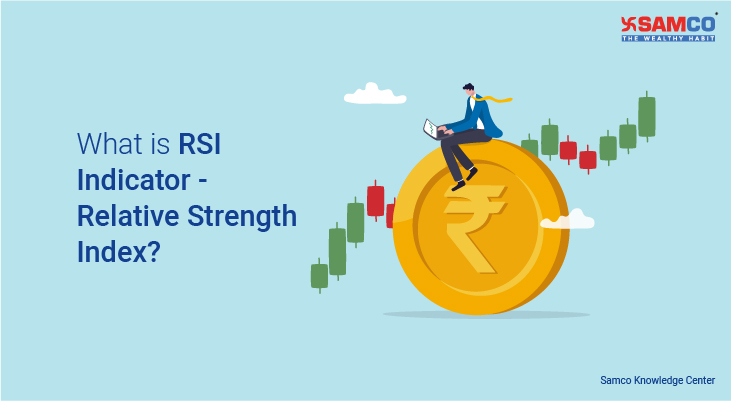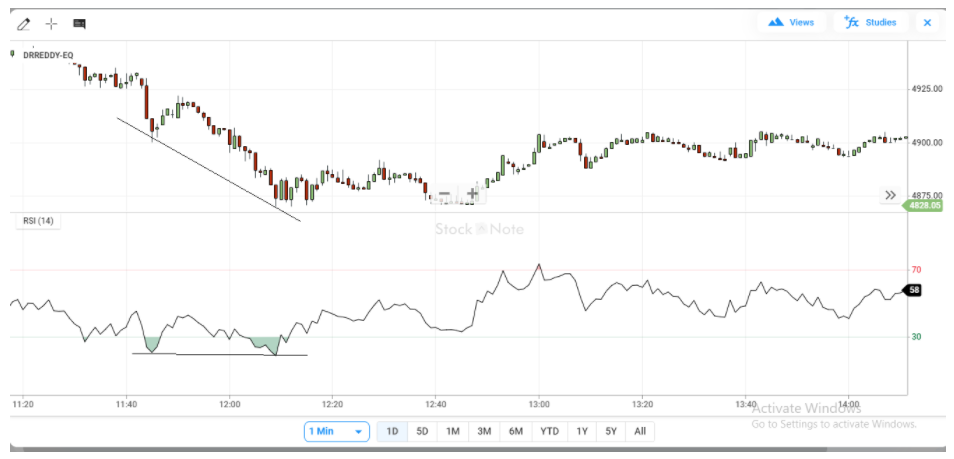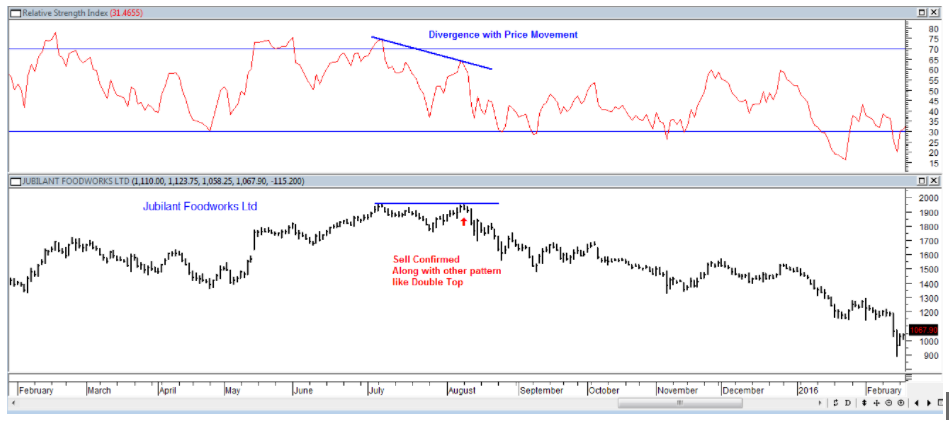In this article:
- What is a momentum indicator?
- What is Relative Strength Index (RSI)?
- The Concept and Formula to calculate RSI Indicator
- How to analyse overbought and oversold regions
- What is RSI divergence?

What is a Momentum Indicator?
The momentum indicator indicates the velocity of a price trend. Basically, it indicates the speed at which the price of a share changes. For example, suppose a stock is trading at Rs 1,000 on Monday. On Tuesday it moves to Rs 1,050 and to Rs 1,100 on Wednesday. This indicates that the stock has a high momentum as it has moved upward by 10% in just 2 days. If the same share would move 10% in two months, then we would say that the stock has a low momentum. Momentum indicator analyses how fast the share price changes. There are several momentum indicators. The rate of Change (ROC) is the most simplest of all. It’s nothing but a percentage change in a stock over a given period. When you plot this percentage change on a chart along with price it becomes the ROC indicator. You can learn everything about Momentum or ROC indicator in this video.What is RSI Indicator?
RSI Indicator was first introduced by J. Welles Wilder in 1978. It is a technical indicator that outlines the strength of a particular share or the index. It ranges from zero to 100.- If the RSI is above 70 then it signals that the stock is overbought.
- While the RSI value is below 30 then it signals that the stock is oversold.
How is RSI Calculated?
RSI is based on the difference between the average closing price of a stock on up days and on the down days. Wilder recommended a time period of 14 days to calculate RSI. It is called a look-back period. Formula to Calculate RSI RSI = 100 – [100 / (1+ Average gain/Average loss)] Here, the average gain is the sum of gains in the past 14 days. The average loss is the sum of losses in the past 14 days. Let’s take an example to understand the concept better. Let’s say a stock is trading at Rs 1,000 on Monday. If on Tuesday the closing price of the stock is Rs 1,004, it means that the stock has gained 4 points. If on Wednesday, the closing price is Rs 1,002 then it has lost 2 points than the previous close. Assuming the previous closing price of the stock was Rs 999. Let’s take a look at the table below.| Day | The closing price of a stock | Gains | Losses |
| 1 | Rs. 1,000 | 1 | 0 |
| 2 | Rs. 1,004 | 4 | 0 |
| 3 | Rs. 1,002 | 0 | 2 |
| 4 | Rs. 1,006 | 4 | 0 |
| 5 | Rs. 1,000 | 0 | 6 |
| 6 | Rs. 997 | 0 | 3 |
| 7 | Rs. 1,007 | 10 | 0 |
| 8 | Rs. 1,010 | 3 | 0 |
| 9 | Rs. 1,008 | 0 | 2 |
| 10 | Rs. 1,012 | 4 | 0 |
| 11 | Rs. 1,015 | 3 | 0 |
| 12 | Rs. 1,011 | 0 | 4 |
| 13 | Rs. 1,015 | 4 | 0 |
| 14 | Rs. 1,020 | 5 | 0 |
| Total | 38 | 17 |
 The chart below the candlestick chart is the RSI indicator. It is set at a default 14-day period. If you carefully look at the chart, there are two levels 70 and 30. When the line graph exceeds 70, we see a red shaded region. This region is overbought zone or we can say that the index is heavily bought and is ready for a downward correction.
So, when the RSI is overbought, Wilder recommended to book profits. Aggressive traders can even find short selling opportunities. But remember to place a short trade only when you see a confirmation from the stock price.
If you are long on a stock, then the oversold region is an indicator that you should be careful while buying the stock.
On the downside, when the Nifty 50 Index hits below 30, we again see a red shaded region. This region is the oversold zone. Once a security hits oversold levels we can see a trend reversal from that point.
Wilder recommended to go long once the RSI is below 30. Short sellers can consider booking profits at this point.
Buying at overbought levels and selling at oversold levels is the traditional approach. We have seen that the traditional approach is full of whipsaws. It doesn’t work as accurately as it did when Wilder invented this indicator.
Hence, traders have modified the traditional RSI to use it in modern times. We have discussed the modified RSI in detail on The Right Choices with Oracles of Dalal Street. Kunal Bothra who is an independent financial advisor and a panelist on ET Now spoke at length about Modified RSI on our show.
You can watch both our episodes.
The chart below the candlestick chart is the RSI indicator. It is set at a default 14-day period. If you carefully look at the chart, there are two levels 70 and 30. When the line graph exceeds 70, we see a red shaded region. This region is overbought zone or we can say that the index is heavily bought and is ready for a downward correction.
So, when the RSI is overbought, Wilder recommended to book profits. Aggressive traders can even find short selling opportunities. But remember to place a short trade only when you see a confirmation from the stock price.
If you are long on a stock, then the oversold region is an indicator that you should be careful while buying the stock.
On the downside, when the Nifty 50 Index hits below 30, we again see a red shaded region. This region is the oversold zone. Once a security hits oversold levels we can see a trend reversal from that point.
Wilder recommended to go long once the RSI is below 30. Short sellers can consider booking profits at this point.
Buying at overbought levels and selling at oversold levels is the traditional approach. We have seen that the traditional approach is full of whipsaws. It doesn’t work as accurately as it did when Wilder invented this indicator.
Hence, traders have modified the traditional RSI to use it in modern times. We have discussed the modified RSI in detail on The Right Choices with Oracles of Dalal Street. Kunal Bothra who is an independent financial advisor and a panelist on ET Now spoke at length about Modified RSI on our show.
You can watch both our episodes.
Episode One
Episode Two
What is RSI Divergence?
The divergence between the RSI and the share price can often be a useful reversal indicator. But what is RSI divergence? Usually, when we look at an RSI Indicator, it moves in synchronization with the stock price. So, when there is an upward trend, the RSI also moves in sync and vice versa. But sometimes, you might come across situations where the RSI has started to diverge from the stock price. Let’s take an example. As we can see in Dr Reddy’s chart, the stock price is not moving in sync with the RSI Indicator. So, when an indicator disagrees with the price and doesn’t move in sync, it indicates that there might be a trend reversal.
Divergences can be of two types.
As we can see in Dr Reddy’s chart, the stock price is not moving in sync with the RSI Indicator. So, when an indicator disagrees with the price and doesn’t move in sync, it indicates that there might be a trend reversal.
Divergences can be of two types.
- Bullish divergence
- Bearish divergence.
 The chart clearly shows a trend reversal because of bullish divergence. Here the RSI is around the oversold levels of 30 and shows divergence with the price action in the Bank Nifty. The index is declining but the RSI isn’t declining. It is an important reversal signal and the RSI indicator generates a buy signal.
A bearish divergence occurs when the indicator moves lower but the price of the security continues to rise.
In the above example, RSI is around overbought levels of 70. It shows divergence with the price action in Jubilant Foodworks. The stock price is going up but RSI hasn’t moved up. It indicates a trend reversal and the RSI indicator generates a sell signal.
RSI divergence is Apurva’s favourite trading strategy. Explore more about RSI Divergence and how can you find valuable opportunities using RSI divergence.
In this video Apurva has revealed his favorite trading strategy. He uses RSI divergences to identify important reversals on various timeframes. You will learn about contrarian trading with RSI divergences from the video. Not just that you will also learn how retail investors can save their time and energy and find high probability trading setups with ease. Apurva has also created a screener for you to identify these reversals. Moreover, he has also shared real life examples of PSU banks where he used this strategy to identify several winning opportunities in 2016 and 2020. We are certain that you won’t find such detailed and insightful video anywhere on the internet. So, watch the video till the end.
Happy Trading
The chart clearly shows a trend reversal because of bullish divergence. Here the RSI is around the oversold levels of 30 and shows divergence with the price action in the Bank Nifty. The index is declining but the RSI isn’t declining. It is an important reversal signal and the RSI indicator generates a buy signal.
A bearish divergence occurs when the indicator moves lower but the price of the security continues to rise.
In the above example, RSI is around overbought levels of 70. It shows divergence with the price action in Jubilant Foodworks. The stock price is going up but RSI hasn’t moved up. It indicates a trend reversal and the RSI indicator generates a sell signal.
RSI divergence is Apurva’s favourite trading strategy. Explore more about RSI Divergence and how can you find valuable opportunities using RSI divergence.
In this video Apurva has revealed his favorite trading strategy. He uses RSI divergences to identify important reversals on various timeframes. You will learn about contrarian trading with RSI divergences from the video. Not just that you will also learn how retail investors can save their time and energy and find high probability trading setups with ease. Apurva has also created a screener for you to identify these reversals. Moreover, he has also shared real life examples of PSU banks where he used this strategy to identify several winning opportunities in 2016 and 2020. We are certain that you won’t find such detailed and insightful video anywhere on the internet. So, watch the video till the end.
Happy Trading



 Easy & quick
Easy & quick
Leave A Comment?